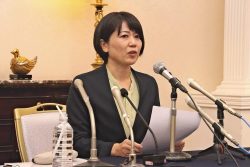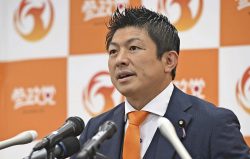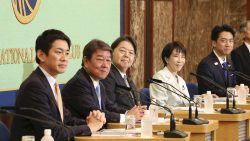
Constitutional Democratic Party of Japan leader Yukio Edano
12:27 JST, January 5, 2021
On the evening of Dec. 10, House of Representatives member Takashi Shinohara of the Constitutional Democratic Party of Japan (CDPJ) stormed into the office of Akira Nagatsuma, acting chairman of the party’s election strategy committee.
“What’s taking you so long?!” Shinohara yelled at Nagatsuma.
Shinohara’s anger was coming from the delay in coordinating a candidate in Niigata Constituency No. 6 for the upcoming lower house election.
The CDPJ’s Niigata prefectural chapter has decided to field rookie Mamoru Umetani, who used to be a member of the Democratic Party for the People (DPFP). However, former House of Councillors lawmaker Naoki Kazama of the CDPJ, who did not run in the 2019 upper house election, has expressed his intention to run in the same constituency, creating a standoff.
Shinohara, who was elected from Nagano Constituency No. 1 and was formerly of the DPFP, has long favored Umetani out of a sense of camaraderie among lawmakers from the regional bloc comprising the Hokuriku region and Niigata and Nagano prefectures. Shinohara brought up the fact that Umetani experienced only a narrow loss in the 2017 lower house election and demanded Nagatsuma “settle on Umetani already!”
Nagatsuma, for his part, told Shinohara that “the party will proceed [with the coordination] carefully,” in order not to create any grudges.
The revamped CDPJ was formed in September after the merger of the CDPJ and DPFP, whereby many members of the latter party left to join the former.
CDPJ leader Yukio Edano decided to merge the two opposition parties in order to create a “large mass” to confront the huge ruling parties. The combined party has now secured triple-digit seats in the lower house with 108 members, a condition that Edano insisted would serve as a “launch pad” for a change of government. The CDPJ already had about 199 official candidates for the next lower house election as of Dec. 22, with Edano boasting “the number will be close to 210 by the end of 2020.”
The number of local assembly members, who are at the party’s beck and call in the lower house election, has also increased from 779 before the merger to 1,048. A senior CDPJ official said with confidence, “We are now ready to fight.”
At the same time, however, the party has become frayed over candidate selection. Out of the nine constituencies in which candidates of the CDPJ and the former DPFP overlapped, the candidates were narrowed down to one in eight of them — all except Niigata Constituency No. 6. However, coordinating candidates in haste is feared to have side effects.
■ Side effects
In Tokyo Constituency No. 9, former Asahi Shimbun reporter Issei Yamagishi, who ran unsuccessfully on the former CDPJ’s ticket in the 2019 upper house election, and Satoshi Takamatsu, a former Nerima ward assembly member backed by former DPFP members, were competing for the candidacy.
A poll conducted by an outside research firm showed that Yamagishi had slightly more votes than Takamatsu, and Takamatsu withdrew his candidacy on the condition that he will be treated well in the following lower house election. However, the constituency in which he will be fielded has not yet been clearly decided — this special treatment was given only in anticipation of a rise in the number of seats being contested in Tokyo constituencies after the rezoning of single-seat electoral districts planned for discussion from 2021.
At the general meeting for the inauguration of the Tokyo Constituency No. 9 general chapter held in Nerima Ward on Dec. 12, Takamatsu cheered on Yamagishi but also stressed, “My ambition for national politics hasn’t changed.” However, those around Takamatsu expressed worry that the offer may merely be “an empty promise” as nothing has yet been decided over the rezoning nor an increase in the number of Diet seats.
In Okayama Constituency No. 3, Akira Uchiyama, a lower house member of the now-defunct Democratic Party of Japan who had been backed by former DPFP members, was absent from a list of CDPJ candidates and was even proposed by the CDPJ headquarters to move to a constituency in the Kanto region. Uchiyama brushed off the proposal as unworthy of consideration and left the party.
■ ‘Wavering’ politics
The cost of putting off policy-making and rushing to join forces has become a factor in the dissonance within the party.
“Politicians should clarify their positions and seek the kind of politics that does not waver,” former upper house vice president Azuma Koshiishi said on Nov. 29 at a convention in Kofu inaugurating the CDPJ’s Yamanashi prefectural chapter.
Koshiishi is the chapter’s chief adviser, and the remark was directed at incumbent Katsuhito Nakajima, who plans to run in Yamanashi Constituency No. 1. Nakajima, an independent lawmaker who joined the CDPJ, is against an immediate elimination of nuclear power plants, so his participation in a party that upholds a policy of “zero nuclear power plants” was seen by Koshiishi as “wavering.”
The former members of the Yamanashi prefectural chapter agreed with Koshiishi and moved to support Tomoko Ichiki, who ran in the 2019 upper house election in the constituency, causing the formation of the new prefectural chapter to stall. After some fuss, the decision was made to endorse Nakajima, but the issue remains unresolved.
Before the merger, the CDPJ, which advocated the early realization of “zero nuclear power plants,” was at odds with the cautious DPFP. In particular, six major industrial unions, which are affiliated with the private sector and have 4.02 million members in total, vehemently opposed the zero-nuclear-plant policy out of fear that their members could lose jobs if nuclear power is abandoned.
The Japanese Trade Union Confederation (JTUC-Rengo), the CDPJ’s largest support group, decided to “support the CDPJ as a whole.” However, lawmakers hailing from such unions as the Japanese Electrical Electronic and Information Union (with 570,000 members) and the Federation of Electric Power Related Industry Worker’s Union of Japan (210,000 members) joined the DPFP instead of the CDPJ at the time of the merger.
On Nov. 13, CDPJ Secretary General Tetsuro Fukuyama visited the office of the Confederation of Japan Automobile Workers’ Unions (JAW) and made a plea: “The Democratic Party for the People will have a tough time in the next lower house election, so please support us.”
Lawmakers hailing from JAW, one of the private industrial federations, have chosen to remain independent, but it will be a blow to the CDPJ if they join the DPFP.
A senior JAW official responded coldly to Fukuyama’s words, saying, “It’s probably the flip side of impatience.”
The “launch pad” may be in place. But, without unity, it will be difficult to chart a course for a change of government.
"Politics" POPULAR ARTICLE
-

Japan to Support Central Asian Logistics Route That Bypasses Russia, Plan to Be Part of Upcoming Summit in Tokyo
-

Japan to Tighten Screening of Foreigners’ Residential Status by Providing Information of Nonpayment of Taxes
-

Chinese, Russian Bombers Flew Unusual Path by Heading Toward Tokyo; Move Likely Meant to Intimidate Japan
-

Japan Plans National Database to Track Foreign Ownership of Real Estate, Land as It Weighs New Rules
-

Up to 199,000 Deaths Estimated From Mega-Tsunami; Most Recent Occurrence Took Place in 17th Century
JN ACCESS RANKING
-

Tokyo Economic Security Forum to Hold Inaugural Meeting Amid Tense Global Environment
-

Keidanren Chairman Yoshinobu Tsutsui Visits Kashiwazaki-Kariwa Nuclear Power Plant; Inspects New Emergency Safety System
-

Imports of Rare Earths from China Facing Delays, May Be Caused by Deterioration of Japan-China Relations
-

University of Tokyo Professor Discusses Japanese Economic Security in Interview Ahead of Forum
-

Japan Pulls out of Vietnam Nuclear Project, Complicating Hanoi’s Power Plans
























